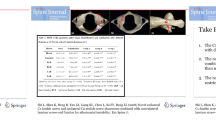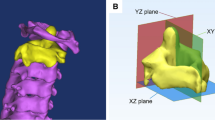Abstract
Introduction
Patients with os odontoideum always present instability in atlantoaxial joint and need atlantoaxial fixation. C2 pedicle or laminar screws fixation has proven to be efficient and reliable for atlantoaxial instability. However, os odontoideum is a congenital or developmental disease, featured with anomalous bony anatomies. The anatomic measurements and guidelines for C2 pedicle screw placement in general population tends to differ with those of os odontoideum patients, for whom C2 pedicle screws are often needed. The option and techniques of C2 fixation are still challenging and yet to be fully explored.
Material and methods
We recruited 29 adult patients with os odontoideum and measured the dimension of C2 pedicle and lamina for each patient to examine how well do they match with the screws anatomically. In order to access the intra-observer reliability and inter-observer repeatability of the measurements, the intraclass correlation coefficient (ICC) was also calculated.
Results
The results for reliability of the CT measurements showed excellent intraobserver (ICC = 0.95 and 0.96) and interobserver correlation coefficient (ICC = 0.93). The diameter and length of C2 pedicle were found to be 6.06 ± 1.37 and 24.05 ± 2.54 mm, while the corresponding figures of C2 laminar were 6.95 ± 0.82 and 25.60 ± 2.18 mm, respectively. In the measurements, all 29 cases had suitable diameter (larger than 5.5 mm) for C2 laminar screw (the laminar diameters ranged from 5.52 to 8.82 mm). In C2 pedicle measurements, the diameters of the 29 cases were from 3.50 to 9.86 mm, while 20 pedicles (34.5%) in 14 cases were less than 5.5 mm in diameter. Six had bilateral small pedicles where the diameter was less than 5.5 mm.
Conclusion
Anatomically, we found laminar screw is a better match in comparison with pedicle screw for C2 fixation in os odontoideum. The options for C2 fixation should be made based on careful preoperative imaging and thorough consideration. Preoperative reconstructive CT scan can offer great assistance for the choice of fixation in os odontoideum by revealing the anatomy of the C2 pedicles in detail.



Similar content being viewed by others
References
Al Kaissi A, Chehida FB, Ghachem MB, Grill F, Klaushofer K (2009) Atlanto-axial segmentation defects and os odontoideum in two male siblings with opsismodysplasia. Skeletal Radiol 38:293–296
Arvin B, Fournier-Gosselin MP, Fehlings MG (2010) Os odontoideum: etiology and surgical management. Neurosurgery 66:22–31
Bhatnagar R, Yu WD, Bergin PF, Matteini LE, O’Brien JR (2010) The anatomic suitability of the C2 vertebra for intralaminar and pedicular fixation: a computed tomography study. Spine J 10:896–899
Cassinelli EH, Lee M, Skalak A, Ahn NU, Wright NM (2006) Anatomic considerations for the placement of C2 laminar screws. Spine (Phila Pa 1976) 31:2767–2771
Dai L, Yuan W, Ni B, Jia L (2000) Os odontoideum: etiology, diagnosis, and management. Surg Neurol 53:106–108 (discussion 108–109)
De Iure F, Donthineni R, Boriani S (2009) Outcomes of C1 and C2 posterior screw fixation for upper cervical spine fusion. Eur Spine J 18(Suppl 1):2–6
Dean CL, Lee MJ, Robbin M, Cassinelli EH (2009) Correlation between computed tomography measurements and direct anatomic measurements of the axis for consideration of C2 laminar screw placement. Spine J 9:258–262
Fagan AB, Askin GN, Earwaker JW (2004) The jigsaw sign. A reliable indicator of congenital aetiology in os odontoideum. Eur Spine J 13:295–300
Fielding JW, Hensinger RN, Hawkins RJ (1980) Os Odontoideum. J Bone Joint Surg Am 62:376–383
Finn MA, Fassett DR, McCall TD, Clark R, Dailey AT, Brodke DS (2008) The cervical end of an occipitocervical fusion: a biomechanical evaluation of 3 constructs. Laboratory investigation. J Neurosurg Spine 9:296–300
Goel A, Desai KI, Muzumdar DP (2002) Atlantoaxial fixation using plate and screw method: a report of 160 treated patients. Neurosurgery 51:1351–1356 (discussion 1356–1357)
Grob D, Bremerich FH, Dvorak J, Mannion AF (2006) Transarticular screw fixation for osteoarthritis of the atlanto axial segment. Eur Spine J 15:283–291
Hammerstein J, Russo S, Easton K (2007) Atlantoaxial dislocation in a child secondary to a displaced chondrum terminale. A case report. J Bone Joint Surg Am 89:413–417
Harms J, Melcher RP (2001) Posterior C1-C2 fusion with polyaxial screw and rod fixation. Spine (Phila Pa 1976) 26:2467–2471
Heuer GG, Hardesty DA, Bhowmick DA, Bailey R, Magge SN, Storm PB (2009) Treatment of pediatric atlantoaxial instability with traditional and modified Goel-Harms fusion constructs. Eur Spine J 18:884–892
Hoh DJ, Liu CY, Wang MY (2010) A radiographic computed tomography-based study to determine the ideal entry point, trajectory, and length for safe fixation using C-2 pars interarticularis screws. J Neurosurg Spine 12:602–612
Jeanneret B, Magerl F (1992) Primary posterior fusion C1/2 in odontoid fractures: indications, technique, and results of transarticular screw fixation. J Spinal Disord 5:464–475
Lu S, Xu YQ, Zhang YZ, Xie L, Guo H, Li DP (2009) A novel computer-assisted drill guide template for placement of C2 laminar screws. Eur Spine J 18:1379–1385
Ma W, Feng L, Xu R, Liu X, Lee AH, Sun S, Zhao L, Hu Y, Liu G (2010) Clinical application of C2 laminar screw technique. Eur Spine J 19:1312–1317
Madawi AA, Casey AT, Solanki GA, Tuite G, Veres R, Crockard HA (1997) Radiological and anatomical evaluation of the atlantoaxial transarticular screw fixation technique. J Neurosurg 86:961–968
Melcher RP, Puttlitz CM, Kleinstueck FS, Lotz JC, Harms J, Bradford DS (2002) Biomechanical testing of posterior atlantoaxial fixation techniques. Spine (Phila Pa 1976) 27:2435–2440
Menezes AH (1999) Pathogenesis, dynamics, and management of os odontoideum. Neurosurg Focus 6:e2
Morgan MK, Onofrio BM, Bender CE (1989) Familial os odontoideum. Case report. J Neurosurg 70:636–639
Neo M, Matsushita M, Iwashita Y, Yasuda T, Sakamoto T, Nakamura T (2003) Atlantoaxial transarticular screw fixation for a high-riding vertebral artery. Spine (Phila Pa 1976) 28:666–670
Panjabi MM, Duranceau J, Goel V, Oxland T, Takata K (1991) Cervical human vertebrae. Quantitative three-dimensional anatomy of the middle and lower regions. Spine (Phila Pa 1976) 16:861–869
Parker SL, McGirt MJ, Garces-Ambrossi GL, Mehta VA, Sciubba DM, Witham TF, Gokaslan ZL, Wolinksy JP (2009) Translaminar versus pedicle screw fixation of C2: comparison of surgical morbidity and accuracy of 313 consecutive screws. Neurosurgery 64:343–348 (discussion 348–349)
Resnick DK, Lapsiwala S, Trost GR (2002) Anatomic suitability of the C1-C2 complex for pedicle screw fixation. Spine (Phila Pa 1976) 27:1494–1498
Sciubba DM, Noggle JC, Vellimana AK, Alosh H, McGirt MJ, Gokaslan ZL, Wolinsky JP (2009) Radiographic and clinical evaluation of free-hand placement of C-2 pedicle screws. Clinical article. J Neurosurg Spine 11:15–22
Spierings EL, Braakman R (1982) The management of os odontoideum. Analysis of 37 cases. J Bone Joint Surg Br 64:422–428
Wang C, Yan M, Zhou H, Wang S, Dang G (2007) Atlantoaxial transarticular screw fixation with morselized autograft and without additional internal fixation: technical description and report of 57 cases. Spine (Phila Pa 1976) 32:643–646
Wang C, Yan M, Zhou HT, Wang SL, Dang GT (2006) Open reduction of irreducible atlantoaxial dislocation by transoral anterior atlantoaxial release and posterior internal fixation. Spine (Phila Pa 1976) 31:E306–E313
Wang MY (2006) C2 crossing laminar screws: cadaveric morphometric analysis. Neurosurgery 59:ONS84–88 (discussion ONS84–88)
Wang S, Wang C (2011) Familial dystopic os odontoideum: a report of three cases. J Bone Joint Surg Am 93:e44
Wang S, Wang C, Passias PG, Yan M, Zhou H (2010) Pedicle versus laminar screws: what provides more suitable C2 fixation in congenital C2-3 fusion patients? Eur Spine J 19:1306–1311
Wang S, Wang C, Wood KB, Yan M, Zhou H (2011) Radiographic evaluation of the technique for c1 lateral mass and c2 pedicle screw fixation in three hundred nineteen cases. Spine (Phila Pa 1976) 36:3–8
Wright NM (2004) Posterior C2 fixation using bilateral, crossing C2 laminar screws: case series and technical note. J Spinal Disord Tech 17:158–162
Yoshida M, Neo M, Fujibayashi S, Nakamura T (2006) Comparison of the anatomical risk for vertebral artery injury associated with the C2-pedicle screw and atlantoaxial transarticular screw. Spine (Phila Pa 1976 31:E513–E517
Yue B, Kwak DS, Kim MK, Kwon SO, Han SH (2010) Morphometric trajectory analysis for the C2 crossing laminar screw technique. Eur Spine J 19:828–832
Conflict of interest
None.
Author information
Authors and Affiliations
Corresponding author
Rights and permissions
About this article
Cite this article
Meng, Xz., Xu, Jx. The options of C2 fixation for os odontoideum: a radiographic study for the C2 pedicle and lamina anatomy. Eur Spine J 20, 1921–1927 (2011). https://doi.org/10.1007/s00586-011-1893-4
Received:
Revised:
Accepted:
Published:
Issue Date:
DOI: https://doi.org/10.1007/s00586-011-1893-4




